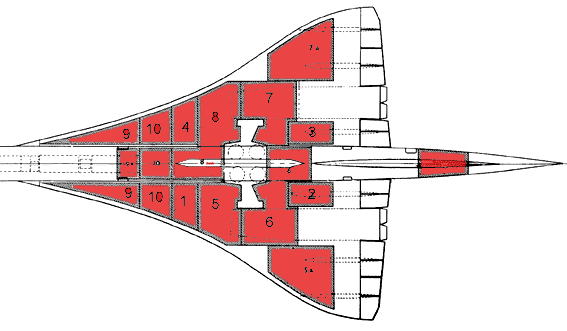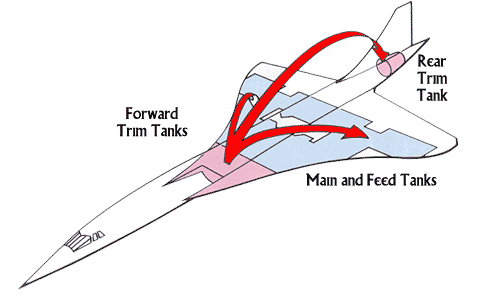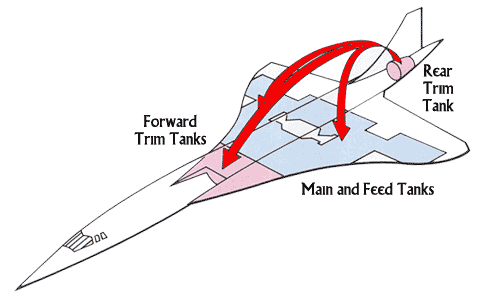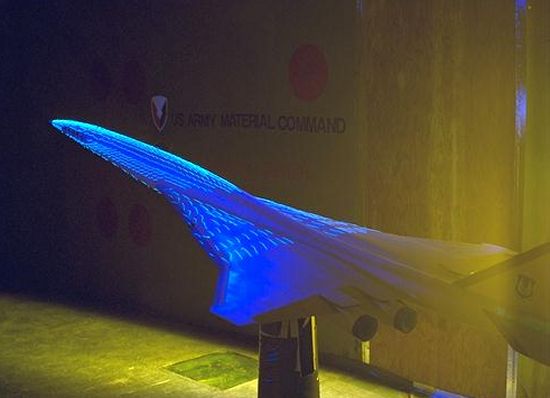|
||||||||||
|
|
||||||||||
|
||||||||||
|
|
||||||||||
Though the Concorde has been retired for the past year, the supersonic transport remains a frequent source of questions. This week's article answers several of the questions we have received and is a continuation of those covered in Part I.

The suggestion was accepted by the British government and forwarded on to the French for their consideration. The
name received informal approval, but it took some time before French president Charles de Gaulle officially
announced the name of the project as Concorde, using the French spelling with an "e." Unfortunately, the British
government by this time had decided that the name should be spelled using the English form Concord without an "e."
The seemingly insignificant issue remained a bone of contention between the two nations for several years.
Finally, at the rollout ceremony for the first prototype in 1967, British Minister of Technology Tony Benn
announced that the British government had officially accepted the name Concorde for the new aircraft.
- answer by Molly Swanson, 24 October 2004

Having multiple fuel tanks is not unusual for any aircraft, especially for very large planes like commercial airliners. What made the Concorde unique was that it required a fuel management system to transfer fuel between the various tanks during flight. Such a system was required because of an aerodynamic effect that occurs around the speed of sound. At these speeds, the point where the lift acts on a wing tends to move around by a large amount. As an aircraft transitions from subsonic to supersonic speeds, the point where the lift generated by the wing acts tends to move further back. Aerodynamicists refer to this behavior as a shift in the center of pressure, and it is caused by the creation of shock waves on the surface of the wing.
The changing center of pressure has a tremendous impact on the stability and controllability of a plane. All planes are equipped with some method of balancing the lift to keep the aircraft flying level. Most conventional planes use a control surface called an elevator to adjust the pitch angle of the aircraft and keep the nose level. The angle of the elevator can be increased or decreased to compensate for changes in the lift generated by the wing and maintain level flight. When the wing and elevator balance each other to keep the plane flying straight and level, we say that the aircraft is in a trim condition.
Keeping the aircraft trimmed becomes more complicated when the center of pressure moves around because it requires much larger and more frequent adjustments to the elevator position. Many aircraft are equipped with a device called a mach trim that is designed specifically for this purpose. When flying near Mach 1 at conditions where the wing center of pressure tends to move a lot, a mach trim system automatically adjusts the position of the elevator to compensate for the movement and keep the plane level. Such a system is common on commercial airliners since these craft usually fly around Mach 0.8 where center of pressure movement starts to become a problem.
Concorde suffered the effects of a shifting center of pressure even more so than traditional airliners. At its cruise speed of Mach 2, the center of pressure had moved a full 6 ft (1.8 m) aft of its location at subsonic speeds. While the plane could have used a traditional elevator control surface to balance the lift, designers decided against it because a horizontal tail would generate too much drag at supersonic speeds. Concorde instead made use of a device called an elevon, which is a control surface that acts like a combination of a traditional elevator and an aileron. A series of these elevons were located along the trailing edge of the wing. Depending on how they were deflected, these elevons could control the Concorde's pitch, like an elevator, or its roll, like an aileron.
The disadvantage of elevons was their inability to compensate for the changes in center of pressure between low speed and high speed flight. Concorde's designers instead adopted a more sophisticated solution. Rather than adjusting aerodynamic forces to keep the plane level as on a traditional plane, engineers chose to adjust the weight distribution of the plane to balance out the changes in aerodynamic lift. Their solution was to pump fuel between different tanks to move the plane's center of gravity forward or aft. The tanks used in this process were known as "trim tanks" since their purpose was to keep Concorde in a trim condition during different phases of flight.

During acceleration through the sound barrier, the aerodynamic center of pressure shifts aft. This effect was compensated for by pumping fuel from the forward trim tanks towards the rear of the plane, as pictured above, to move the center of gravity aft. A total of about 20 tons (40,000 lb or 18,145 kg) of fuel was transferred aft, shifting the center of gravity by 6 ft (1.8 m) in the process.

Once the cruise portion of flight was concluded and the plane began to decelerate back to subsonic speeds, the center of pressure started shifting forward again. Fuel was then pumped back into the wing transfer tanks or forward trim tanks to move the center of gravity forward. Additional fuel was also often pumped forward after landing to keep the plane balanced during the unloading of passengers and cargo.

The above graph illustrates how the Concorde's center of gravity was moved over the different phases of a typical
flight. Also note the dashed lines showing the furthest forward or aft the center of gravity could be at a given
speed for the plane to continue flying safely. The task of properly managing the fuel distribution during flight
was the most important duty of the flight engineer.
- answer by Joe Yoon, 24 October 2004
Perhaps the best hope for a Concorde replacement came in the 1990s when NASA conducted its High Speed Civil Transport (HSCT) research effort. The goal of HSCT was to investigate new technologies that could potentially reduce the operating costs of a supersonic transport to be competitive with a typical subsonic airliner.

The most important hurdle addressed by NASA was to reduce the fuel consumption problems that plagued Concorde. Although Concorde's builders were justifiably proud of the plane's ability to cut transatlantic travel times by more than half, the problem was that the plane burned three times as much fuel in the process. The high price of oil over the past 30 years made the Concorde so expensive to fly that the airline market could not afford it. NASA investigated new advances in jet engine technology that might be able to reduce fuel consumption to more acceptable levels.
Furthermore, the Concorde's engines generated a large amount of pollutants like nitrogen oxide, particulates, and ozone-depleting substances during cruise flight. These engines were also notoriously loud during takeoff generating noise pollution complaints from those living near airports. Both forms of pollution have become increasingly restricted under more recent environmental laws. NASA's researchers looked at ways of reducing these forms of pollution to reduce the environmental impact of a future supersonic plane.

The HSCT program also looked at a number of other technological solutions to reduce costs and improve performance. For example, researchers studied the development of advanced composite materials and new methods of structural design that could improve the plane's ability to survive high temperatures while reducing weight and manufacturing costs. NASA also studied possible methods of reducing the effects of sonic booms as well as electronic displays to eliminate the need for cockpit windows and the complicated drooping nose mechanism.
NASA had hoped that its investment in these advanced technologies would encourage commercial aircraft manufacturers to build a more efficient and cost effective replacement for Concorde that would revolutionize airline travel. In particular, NASA formed a partnership with Boeing to share research and reduce the development costs of such an ambitious project. Unfortunately, Boeing's market research indicated that the airlines had little interest in such a plane because it would still be much more expensive than traditional subsonic aircraft. This lack of success prompted NASA to discontinue HSCT research in 1999, and Boeing has shelved the concept indefinitely.

Other nations have also investigated developing a Concorde replacement, including Europe's Airbus consortium, Japan, and Russia. Russia's Tupolev had previously developed its own rival to Concorde called the Tu-144 and proposed a more advanced Tu-244 during the 1990s. The concepts for this plane look very similar to the American HSCT, and the Tu-244 incorporates many of the same advanced technologies to improve economy and impact on the environment. Though Tupolev has attempted to generate interest in such a plane, response from airlines has been poor and the idea appears to have all but died.

More extreme proposals for Concorde "replacements" are far more ambitious, such as
hypersonic transports cruising at Mach 5 or better. Test programs like the
X-43 and pulse
detonation engine experiments are already developing the basic technologies needed to make hypersonic aircraft
a reality. However, building large hypersonic planes safe enough for airline travel is an enormous leap beyond the
Concorde or HSCT that will likely take decades to develop.
- answer by Jeff Scott, 24 October 2004
Related Topics:
Read More Articles:


|
Aircraft | Design | Ask Us | Shop | Search |

|
|
| About Us | Contact Us | Copyright © 1997- | |||
|
|
|||